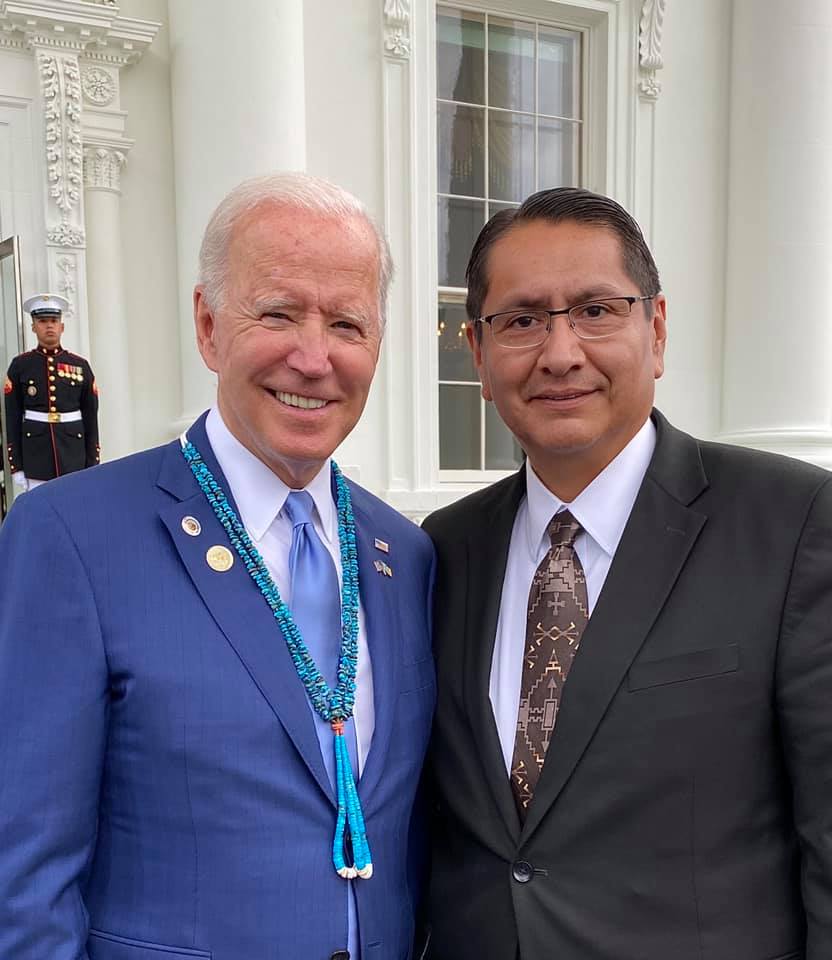
- Details
- By Levi Rickert
Former Navajo Nation President Jonathan Nez on Monday announced his campaign for Arizona’s Second Congressional District. Nez is a Democrat who will seek to unseat incumbent Republican Eli Crane, right-wing conservative, in the election in November 2024.
Nez served as president of the Navajo Nation until January 10, 2023. He was succeeded by current Navajo Nation President Buu Nygren.
Elected president of the Navajo Nation in 2019, Nez through his decisive and compassionate leadership led the Navajo people through the COVID-19 pandemic. The Navajo Nation was hit hard by the pandemic. Nez secured and oversaw resources to construct new health care facilities and homes for veterans, invested in public safety by hiring new police officers, and bolstered infrastructure, improving rural roads and bringing clean water and electricity to thousands of previously unserved residents. During 2020, he gained much national press coverage during the pandemic.
In announcing his candidacy on Monday, Nez cited his humble upbringing in a rural, low-income home that lacked electricity and running water.
“I grew up in a rural, low-income home, in a long-overlooked community where my family lived paycheck-to-paycheck, worried about how we’d make ends meet. I understand the struggles that many Arizona families are facing right now,” Nez said.
Arizona’s second congressional district is now represented by Rep. Crane, who is serving in his first term. In his race for the congressional seat in 2022, he was endorsed by Donald Trump in the congressional race and beat three-term incumbent Rep. Tom Tom O’Halleran (D-AZ) by winning 53.9 percent of the vote to 46.1 percent. Two weeks ago, Crane was one of eight Republicans who voted to oust former Speaker Kevin McCarthy (R-CA). In January 2023, he was one of several Republicans that forced McCarthy to face 15 votes before gaining the speakership. During the 15th vote, Crane would not commit to McCarthy, but simply voted "present" that ultimately allowed McCarthy to become speaker.
The congressional district includes Apache, Coconino, Graham, Greenlee and Navajo counties and contains parts of Gila, Maricopa, Mohave, Pima, Pinal and Yavapai counties. It covers parts of the low desert south of Phoenix, widening east to the New Mexico border, then north to Utah and curving back west over Flagstaff to the Grand Canyon.
Prior to redistricting, part of the Navajo Nation in Arizona was in the state’s first congressional district. After redistricting, that portion became part of the second congressional district. The congressional includes 12 Native American tribes. Native Americans make up 22 percent of the voters in the district.
“In Congress, I’ll fight for Arizona working families by cutting high gas and food costs, creating jobs, expanding access to affordable, quality health care, addressing climate change, expanding opportunities for small businesses, investing in rural communities, and supporting our veterans.”
Nez, 48, was born in Tuba City, Arizona and raised in Shonto, Arizona. He currently lives in Flagstaff with his wife Phefelia and their sons Christopher and Alexander. Nez is an enrolled member of the Navajo Nation. He is Áshįįhí (Salt People) born for Ta’neeszahnii (Tangle clan). His maternal grandfather’s clan is Tódích’íi’nii (Bitter Water Clan) and paternal grandfather’s clan is Táchii’nii (Red-Running-Into-The-Water Clan).
At 29, Nez began his political career in public service as the Vice President of the Shonto Chapter on the Navajo Nation. Passionate about serving his community, he went on to serve on the Navajo Nation Council and the Navajo County Board of Supervisors before eventually being elected vice president of the Navajo Nation in 2015.
“We need leadership in Congress that will put aside the politics of drama and division and fight for rural Arizona families instead,” continued Nez. “We cannot afford to have representatives who take us to the brink of a government shutdown just to prove a political point. I’m ready to take on the tough challenges and stand up for hardworking Arizona families.”
More Stories Like This
Native News Weekly (August 25, 2024): D.C. BriefsUS Presidents in Their Own Words Concerning American Indians
NDAA passes House; Lumbee Fairness Act Advances
NFL, Vikings to Host Native All-American Game, Youth Flag Clinic
Senate Committee on Indian Affairs Passes 12 Bills to Strengthen Tribal Communities
Help us defend tribal sovereignty.
At Native News Online, our mission is rooted in telling the stories that strengthen sovereignty and uplift Indigenous voices — not just at year’s end, but every single day.
Because of your generosity last year, we were able to keep our reporters on the ground in tribal communities, at national gatherings and in the halls of Congress — covering the issues that matter most to Indian Country: sovereignty, culture, education, health and economic opportunity.
That support sustained us through a tough year in 2025. Now, as we look to the year ahead, we need your help right now to ensure warrior journalism remains strong — reporting that defends tribal sovereignty, amplifies Native truth, and holds power accountable.
 The stakes couldn't be higher. Your support keeps Native voices heard, Native stories told and Native sovereignty defended.
The stakes couldn't be higher. Your support keeps Native voices heard, Native stories told and Native sovereignty defended.
Stand with Warrior Journalism today.
Levi Rickert (Potawatomi), Editor & Publisher


